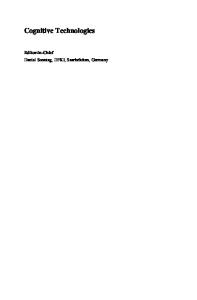On Law, Philosophy and Technology
What a new generation of issues concerning robotic crimes, contracts, and torts have in common is the legal quest to define who is responsible for a robotic act or omission: when something goes wrong, “Who Pays?” Lawyers accordingly determine different le
- PDF / 469,410 Bytes
- 26 Pages / 439.37 x 666.14 pts Page_size
- 72 Downloads / 391 Views
On Law, Philosophy and Technology
Now where are we? Exactly at the explanation. The conflict between the various rules is ironed out by the different positronic potentials in the brain. Isaac Asimov, Runaround
Abstract What a new generation of issues concerning robotic crimes, contracts, and torts have in common is the legal quest to define who is responsible for a robotic act or omission: when something goes wrong, “Who Pays?” Lawyers accordingly determine different levels of responsibility and agency in the field of legal robotics, by ascertaining whether such autonomous and even “intelligent” machines should be reckoned as legal persons, proper agents, or mere sources of legal responsibility in the system. Three different scenarios for a hard case in positive law concern the personhood of robots, their accountability in contracts, and new types of human responsibility for the behaviour of others. However, “Who pays?” often means different things in such fields as criminal law, contracts, and torts, e.g., the level of robotic autonomy that at times is sufficient to produce relevant effects in the field of contractual obligations, arguably is insufficient to bring robots before judges and have them declared guilty in criminal courts. Research within the philosophy of technology and the sociology of the law, suggesting that the law should regulate scientific research and technology, can be likened to the classical image of Achilles and the turtle. By reversing Zeno’s paradox, the pace of the law seems too slow to catch up with the race U. Pagallo, The Laws of Robots: Crimes, Contracts, and Torts, Law, Governance and Technology Series 10, DOI 10.1007/978-94-007-6564-1_2, © Springer Science+Business Media Dordrecht 2013
19
20
2 On Law, Philosophy and Technology
of science and technological innovation. Since Galileo’s trial in 1633 to the current debate on neuroscience and bioethics, politicians and lawmakers believed otherwise. Even though we literally can arrest the pace of scientists, e.g., Galileo, the argument proffered is that the race of technology is so determined and powerful that it cannot be deterred by legal means. In his telling research on What Technology Wants (2010), Kevin Kelly suggests why this is the case. He draws a directly proportional rule between features and outputs of technology: “the greater the number of exotropic traits we observe in a particular expression of technology, the greater its inevitability and its conviviality” (op. cit., 270). Once we understand the laws under which humans have been using tools for over hundreds of thousands of years, unveiling an already written future appears feasible. Contrary to the laws of the law, the laws of technology allow us to find the logic of human evolution: starting with the hero of the ape-like tribe of early humans grasping how a bone could be used as a weapon, down to the orbital satellite in Kubrick’s famous match cut in 2001: A Space Odyssey. This view on technology has induced one distinguished researcher from Carnegie Mellon, Hans
Data Loading...











